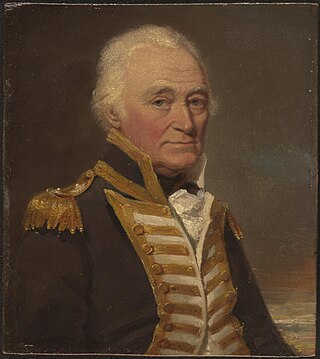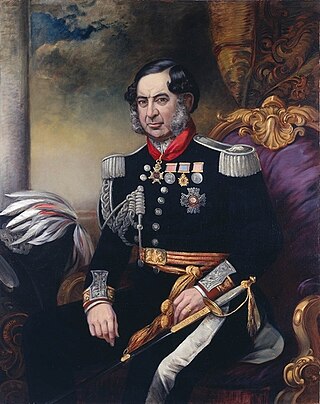| |||||
| Decades: | |||||
|---|---|---|---|---|---|
| See also: | |||||
The following list contains events that happened during 1800 in Australia.
| |||||
| Decades: | |||||
|---|---|---|---|---|---|
| See also: | |||||
The following list contains events that happened during 1800 in Australia.
This article describes the history of the Australian colony and state of Victoria.

Vice Admiral John Hunter was an officer of the Royal Navy, who succeeded Arthur Phillip as the second Governor of New South Wales, serving from 1795 to 1800.

Philip Gidley King was a British politician who was the third Governor of New South Wales.
James Grant was a Scottish born British Royal Navy officer and navigator in the early nineteenth century. He served in Australia in 1800-1801 and was the first to map parts of the south coast of Australia.
The New South Wales Corps, sometimes known as The Rum Corps was a regiment of the British Army, formed in England in 1789, to relieve the New South Wales Marine Corps, which had accompanied the First Fleet to Australia. In the Colony of New South Wales, the New South Wales Corps gained notoriety for its trade in rum and mutinous behaviour.

John Macarthur was a British Army officer, entrepreneur, landowner and politician who was a highly influential figure in the establishment of the colony of New South Wales. He was also a pioneer of the Australian Merino wool industry, and was instrumental in agitating for, and organising, a rebellion against Governor William Bligh in what is now termed as the Rum Rebellion in January 1808.

His Majesty's Armed Survey Vessel Lady Nelson was commissioned in 1799 to survey the coast of Australia. At the time large parts of the Australian coast were unmapped and Britain had claimed only part of the continent. The British Government were concerned that, in the event of settlers of another European power becoming established in Australia, any future conflict in Europe would lead to a widening of the conflict into the southern hemisphere to the detriment of the trade that Britain sought to develop. It was against this background that Lady Nelson was chosen to survey and establish sovereignty over strategic parts of the continent.
The following lists events that happened during 1788 in Australia.
The following lists events that happened during 1790 in Australia.
The following lists events that happened during 1794 in Australia.
The following lists events that happened during 1797 in Australia.

Sir Charles Augustus FitzRoy, was a British military officer, politician and member of the aristocracy, who held governorships in several British colonies during the 19th century.

Henry Lidgbird Ball was a Rear-Admiral in the Royal Navy of the British Empire. While Ball was best known as the commander of the First Fleet's HMS Supply, he was also notable for the exploration and the establishment of colonies around what is now Australia and New Zealand. Specifically, Ball explored the area around Port Jackson and Broken Bay, helped establish the Norfolk Island penal settlement, and discovered and named Lord Howe Island.
The following lists events that happened during 1804 in Australia.

Lieutenant-Colonel George Johnston was a British military officer who served as Lieutenant-Governor of New South Wales, Australia after leading the rebellion later known as the Rum Rebellion. After serving as a young marine officer in the American Revolutionary War, Johnston served in the East Indies, fighting against the French, before volunteering to accompany the First Fleet to New South Wales. After serving as adjutant to Governor Arthur Phillip, Johnston served in the New South Wales Corps and he was a key figure in putting down the Castle Hill convict rebellion in 1804. He led his troops in deposing Governor Bligh in the Rum Rebellion in 1808; which led to his court martial and subsequent cashiering from military service. In his later life, he returned to New South Wales as a private citizen, raising a family in the colony and establishing a successful farm around Annandale in Sydney.
The following lists events that happened during 1836 in Australia.

HMS Porpoise was a 12-gun sloop-of-war originally built in Bilbao, Spain, as the packet ship Infanta Amelia. On 6 August 1799 HMS Argo captured her off the coast of Portugal. Porpoise wrecked in 1803 on the North coast of what was then part of the Colony of New South Wales, now called Wreck Reefs, off the coast of Queensland, Australia.

There are 20 known contemporary accounts of the First Fleet made by people sailing in the fleet, including journals and letters. The eleven ships of the fleet, carrying over 1,000 convicts, soldiers and seamen, left England on 13 May 1787 and arrived in Botany Bay between 18 and 20 January 1788 before relocating to Port Jackson to establish the first European settlement in Australia, a penal colony which became Sydney.
HMS Supply was the American mercantile New Brunswick that the British Royal Navy purchased in October 1793 as a replacement for HMS Supply, which the Navy had sold in the year before.

Captain William George Carlile Kent was an officer in the Royal Navy, who was involved in the early settlement of the Colony of New South Wales, Australia.